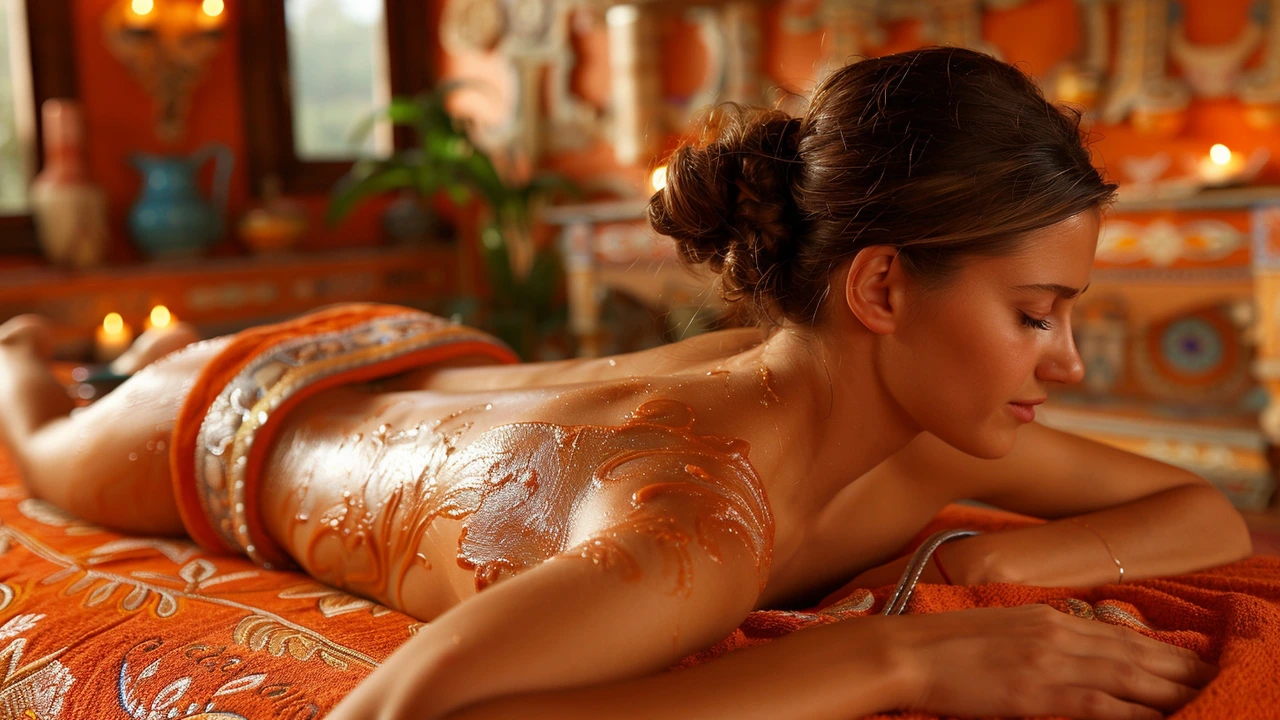My Unique Adventure with Knife Massage Therapy: An Honest Review
 Jun, 20 2024
Jun, 20 2024
Imagine the cool touch of a blade lightly grazing your skin, not to harm but to heal. Welcome to the world of knife massage therapy, an age-old practice transforming the modern wellness scene. Intrigued by the buzz, I embarked on this unexpected journey to understand what makes this therapy so special and whether it's truly effective.
- Introduction to Knife Massage
- Historical Background
- The Experience
- Benefits of Knife Massage
- Tips for First-Timers
Introduction to Knife Massage
Knife massage therapy is an ancient practice that might sound a bit intimidating at first. The thought of a blade touching one’s skin can evoke a sense of danger. However, knife massage is a therapeutic technique that focuses on relaxation and healing, not harm. Originating from Asia, particularly Taiwan and China, this unique massage technique has been around for over two thousand years. Often, it is called 'Daoliao' in Chinese, which directly translates to 'knife massage.'
Practitioners use blunt knives to gently press, scrape, and stroke different parts of the body, effectively working to release tension and improve circulation. These knives are specially designed to avoid causing any injuries, with their edges carefully blunted to provide a safe experience. The therapist wielding these knives is highly skilled, ensuring that the therapy is both safe and effective. It is believed that the blade's touch releases trapped negative energy, much like how acupressure works.
Knife massage therapy relies heavily on the ancient concept of 'Qi,' or life energy. The belief is that emotional distress, physical pain, and other ailments are caused by blockages or imbalances in one's Qi. By utilizing the gentle yet firm touch of knives, these blockages can be relieved, allowing Qi to flow freely throughout the body. Studies and anecdotal evidence from users have reported enhanced relaxation, reduced stress, and improved overall well-being after knife massage sessions.
According to Dr. Wen Lee, a renowned expert in alternative medicine, 'Knife massage has deep roots in traditional Chinese medicine and is a testament to the ingenuity of ancient healing practices. When done correctly by experienced practitioners, it can offer significant health benefits.'
The process begins much like any other massage therapy with the client lying down comfortably. The therapist then uses the knives to apply rhythmic, scraping strokes on specific meridians of the body. These knives tap into critical points, somewhat similar to acupuncture, intended to balance the body's energy and eliminate toxins. The result is a unique sensation that many describe as deeply relaxing and refreshing.
Historical Background
Knife massage, or "dao liao," traces its roots back to ancient China, with records dating as far back as 2,000 years ago. This unique therapy emerged during the Han Dynasty, often used by monks as a method to balance the body's energy and alleviate stress. The practice has its foundation in principles similar to those of traditional Chinese medicine, focusing on the flow of qi (chi) through the body.
Initially, knife massage was reserved for royalty and the elite, signifying its importance and perceived effectiveness. The techniques were closely guarded secrets, meticulously passed down through generations within certain families or monastic orders. Over time, these secrets slowly trickled down to the common populace, and the practice spread across different regions. The precision and skill required in knife massage were so revered that practitioners were not just therapists but also held in high esteem as healers.
As traditional medicine evolved, the art of knife massage witnessed a decline, overshadowed by more conventional forms of therapy. However, it saw a revival in Taiwan during the late 20th century. Practitioners there adapted the ancient methods to contemporary wellness needs, propagating its benefits beyond Asia. Modern knife massage incorporates elements from other therapeutic practices, melding ancient wisdom with new-age wellness trends. This resurgence in interest has also prompted scientific inquiry into its efficacy, albeit limited.
Knife massage as a practice is not without its critics. Skeptics question the safety and effectiveness of using blades for massage. Nevertheless, its growing popularity attests to a broader acceptance in the world of alternative medicine. Today, knife massage is practiced globally, from upscale spas in Tokyo to wellness retreats in California. Dr. Tsai, a notable Taiwanese practitioner, often quips,
"The blade does not cut; it heals the spirit and rejuvenates the soul."Such testimonials emphasize the psychological and emotional benefits attributed to this ancient practice.

The Experience
Arriving at the spa, a mix of anticipation and curiosity buzzed in the air. The environment was serene, much like any high-end wellness center. I was greeted with a warm smile by the therapist, who explained each step before we began. Knowing the journey I was about to undertake, with knives no less, required trust and openness.
First, I reclined on a comfortable massage table, with gentle music and dim lighting setting the mood. A brief consultation followed, assessing my comfort level and any specific areas needing attention. The tools were already laid out, and my eyes couldn't help but wander to the *knives*, their presence blending oddly with the tranquil setting.
As the session began, the blade's touch was surprisingly gentle. Starting at my shoulders, it glided smoothly, arousing a sensation both unique and soothing. The pressure varied, controlled with precise skill. My initial apprehension slowly diminished, replaced by an unexpected sense of calm.
The therapist maintained constant communication, ensuring my comfort. This back-and-forth was vital; trust here was paramount. As we progressed, I could feel the tension releasing from muscles I didn't even realize were tight. Each stroke seemed to melt away stress layers, a paradoxical blend of sharpness and relief.
“Knife massage has a profound ability to access deep tissue without the typical discomfort,” says renowned wellness expert, Dr. Eleanor Brooks. “The technique, when executed properly, can be extraordinarily beneficial.”This insight resonated deeply as the session continued. The blades worked wonders on knots and tension areas, a silent dialogue between my body and the careful strokes of the knives.
Halfway through, I even managed to relax enough to close my eyes. It was like my body knew it was in good hands, despite the rather unconventional methods. The tactile feedback was unlike any other massage I'd experienced, a rhythmic dance of blade and skin.
One of the most surprising aspects was the sensation of energy flow. Knife massage, it seems, channels not just physical relaxation but an invigorating energy. Every movement felt measured, almost meditative. By the end, I felt both deeply relaxed and oddly energized, my muscles soft but my mind alert.
To wrap up, a brief cooling down session followed, the knives replaced by warm towels and soft strokes. It was the perfect closure to an incredibly unique experience. Walking out, I felt a notable lightness, my muscles loose and mind clear. The previously intimidating concept of a knife massage had been completely reframed into an experience of renewal and tranquility.
Benefits of Knife Massage
Imagine lying on a massage table, blinds closed, deep breaths in sync with the soft music in the background. Suddenly, you feel the cool blade of a knife, but don't be alarmed; you're in the midst of a unique healing experience known as knife massage therapy. This ancient practice offers a host of benefits that extend far beyond relaxation. Many fans of knife massage claim pain relief as the biggest perk.
Though it might sound intense, the gentle strokes of the blades can reach deeper muscle layers. This technique helps in reducing muscle tension, making it particularly effective for those suffering from chronic pain conditions. Another interesting benefit is the improvement in circulation. The unique strokes stimulate blood flow, enhancing oxygen and nutrient distribution throughout the body.
Another remarkable advantage is its ability to help in emotional release. Knife massage has a way of drawing out pent-up emotions, leaving individuals feeling lighter and more balanced. This can be attributed to the holistic approach that combines physical and emotional well-being. A study published in the Journal of Alternative and Complementary Medicine mentioned, "Knife massage techniques have been shown to produce a state of relaxation and emotional release not commonly found in other massage therapies."
Stress reduction is another prominent benefit. The soothing rhythm of the knife movements can induce a state of deep relaxation, which helps in reducing stress hormones like cortisol. People report feeling more serene and centered post-session. In fact, many therapists incorporate aromatherapy during the session to enhance these calming effects.
For those dealing with insomnia, knife massage could offer a soothing solution. The therapy can help reset your internal clock and improve sleep quality by creating a state of deep relaxation. Additionally, some believe that it can also boost the immune system. By promoting better circulation and decreasing stress, the body can better defend itself against illness.
While it may seem a bit unorthodox, the combination of physical, emotional, and psychological benefits makes knife massage a fascinating alternative therapy worth considering. Whether it's the deep muscle relief, the emotional balance, or the improved sleep, the potential perks are eye-catching enough to make anyone curious to give it a try.

Tips for First-Timers
Diving into the world of knife massage can be both thrilling and intimidating. If you're curious about trying this unique therapy, it helps to go in prepared. Knowing what to expect and how to approach a session can make all the difference in having a positive experience.
First, it's crucial to do your research. Not all practitioners are the same. Seek someone with a solid reputation, extensive training, and positive reviews. Though knife massage therapy can be found in various parts of the world, quality and technique can vary greatly. Ask potential therapists about their experience and training. A well-trained practitioner will be more than happy to share their background with you.
When preparing for your session, dress comfortably. Wearing loose-fitting clothes that can easily be adjusted or removed helps the therapist access different parts of your body without any restrictions. Also, avoid heavy meals before your appointment. A light snack is fine, but being too full or too hungry can make it hard to relax.
During the session, communication is key. Don't hesitate to share your comfort level and any concerns you might have. A reputable therapist will check in with you regularly, ensuring you're at ease every step of the way. If something feels too intense or uncomfortable, speak up immediately. Knife massage should never cause pain.
It's also beneficial to have an open mind about the experience. Some might find the sensation of the blades strange or even unsettling at first. That's perfectly normal. Relaxation and trust play significant roles in how effective the session will be. Breathe deeply, focus on the sensations, and try to let go of any preconceived apprehensions.
According to Dr. Mark Hyman, a renowned wellness expert, "Exploring alternative therapies gives us insight into the versatility of healing practices around the world. We might find unconventional methods that resonate uniquely with our personal health journeys."
Post-session care is just as important as the session itself. Drinking plenty of water helps to flush out toxins released during the massage. Some people might experience mild soreness, akin to the feeling after a deep tissue massage. This is normal and should subside within a day or two. Gentle stretching and warm baths can help alleviate any lingering discomfort.
Lastly, if you're considering making knife massage a regular part of your wellness routine, track how you feel after a few sessions. Keep notes on any improvements or changes in your physical and emotional well-being. Many people report enhanced relaxation, reduced muscle tension, and improved sleep. These observations can help you decide if knife massage is a beneficial addition to your self-care regimen.
- Research Your Therapist - Ensure they have proper training and positive reviews.
- Dress Comfortably - Loose clothing allows for easy access to your body.
- Communicate Openly - Don't hesitate to express any discomfort or concerns.
- Stay Hydrated - Drink plenty of water before and after your session.
- Track Your Experience - Note any physical or emotional changes you observe.
